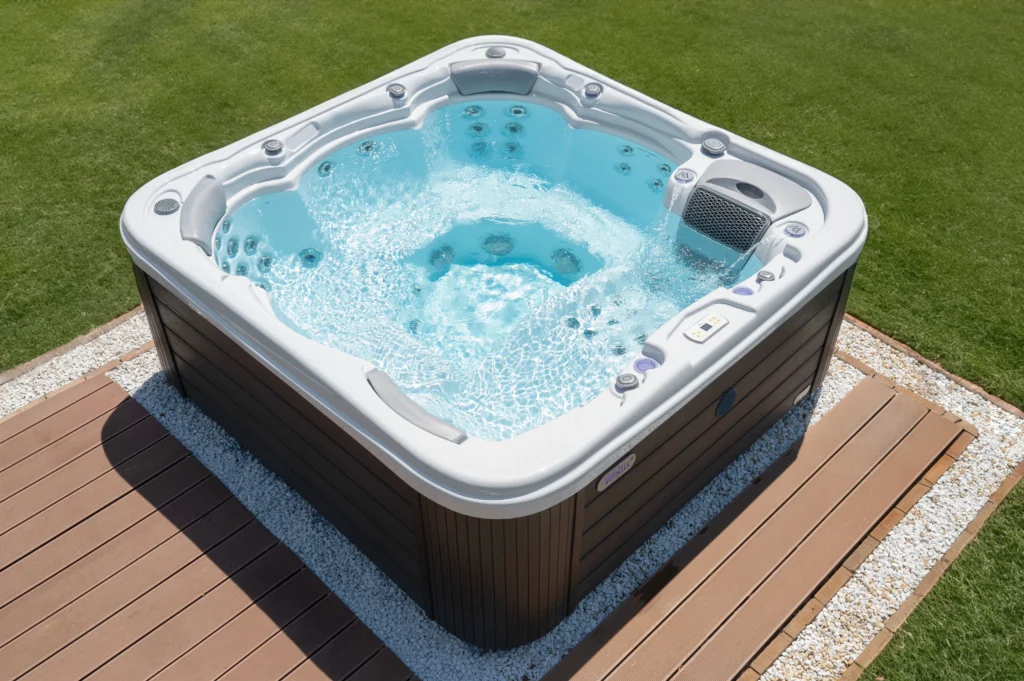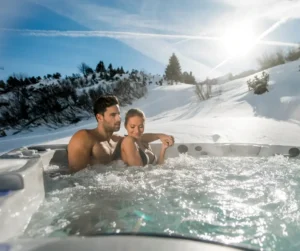Did you order a water consultation from Epic Hot Tubs? You need to follow our…

How To Fill a Hot Tub or Swim Spa For The First Time? 7 Problems To Avoid
Expect to learn how to expertly fill your hot tub or swim spa, sidestep common issues, and budget for filling costs with this practical guide.
If you’ve finally taken the plunge and invested in your dream hot tub or swim spa, congratulations! There’s nothing quite like sinking into perfectly heated, bubbling water after a long day. But before you can kick back and relax, you’ll need to fill it up properly. And trust us, you don’t want to miss out on the little details that make a big difference.
In this guide, we’ll cover:
- The best methods for filling your hot tub or swim spa safely and efficiently
- Key pitfalls to avoid that could endanger your tub’s longevity
- Simple tips to maintain a pristine, balanced spa environment
Ready to start relaxing in your new spa? Let’s get started!
Quick Guide
| Step | How to Do It |
| Step 1: Position Your Hot Tub Properly | Set the tub on a stable, level surface and ensure all electrical connections are correctly installed before filling. |
| Step 2: Begin the Fill Slowly | Attach your hose and fill gradually to avoid stressing the tub’s plumbing or causing airlocks. |
| Step 3: Monitor the Water Level | Keep an eye on the water level to reach the manufacturer’s indicated fill line and avoid overfilling. |
| Step 4: Pause to Check Chemical Levels | Stop filling near the top to test and adjust pH and sanitizer levels, ensuring balanced and safe water. |
| Step 5: Finish the Fill with Caution | Continue filling until the correct level is reached while checking for smooth water flow and any signs of pressure issues. |

Preparing for the Big Fill: What You Need
Before you turn on the tap, it’s essential to be organized. Here’s a checklist of items to have on hand:
- Garden hose or dedicated water source – Make sure it’s in good shape without any leaks.
- Water testing kit – Essential for checking pH and sanitizer levels.
- Chemicals for initial water balance – You’ll need pH increasers or decreasers and sanitizers like chlorine or bromine.
- Clean filter and debris net – To catch unwanted particles as the water flows in.
Taking a few minutes to gather these items means you’re not scrambling later. Honestly, a little prep work can save you from a world of trouble.
Choosing Your Filling Method: Garden Hose vs. Direct Water Supply
Garden Hose: The Classic Approach
Using a garden hose is a tried-and-true method for filling your hot tub. It’s simple, accessible, and gives you control over the flow rate. However, before using a hose, you’ll need to make sure that:
- The hose is clean and free of any chemicals that could affect the water quality.
- You’re mindful of the water pressure—too high and it might stress the hot tub’s plumbing components.
Direct Water Supply: The Built-in Option
Some hot tubs come with a direct water connection. This can offer a faster fill and sometimes a better-controlled water flow. If you have this option:
- Check that the water pressure is calibrated for your tub’s design.
- Confirm with your manufacturer’s guide that this method is recommended for your model.
Both methods have their merits, so it really boils down to what’s available and what the manufacturer advises. Remember, the goal is to have a gentle, steady fill that avoids unnecessary stress on the tub’s systems.
Step-by-Step Guide to Filling Your Hot Tub
Step 1: Position Your Hot Tub Properly
Before you even get to filling it, make sure your hot tub is set on a stable, level surface. This is critical not just for a smooth fill but also for safety and longevity. Check that the area is clear of debris and that the electrical connections (if applicable) are correctly installed.
Step 2: Begin the Fill Slowly
When you’re ready, attach your hose and start filling. It’s best to do this slowly to avoid putting pressure on the hot tub’s structure. Let the water flow gently, and keep an eye out for any unusual noises or signs that something isn’t right.
Step 3: Monitor the Water Level
Keep checking the water level as it rises. You want to reach the “fill line” indicated by your manufacturer. Overfilling can lead to water spilling into the equipment area, which might cause damage or affect the tub’s circulation system.
Step 4: Pause to Check Chemical Levels
Once you’re nearing the desired level, stop filling and test the water’s pH and sanitizer levels. This is the perfect time to add any necessary chemicals. Adjusting your water balance early on can help prevent problems such as scale buildup or corrosion.
Step 5: Finish the Fill with Caution
After making adjustments, continue filling until you hit the correct level. Ensure the water remains clear and that there’s no sudden change in flow or pressure. A smooth finish sets the stage for proper filtration and heating.
Understanding Swim Spa and Hot Tub Filling Costs
Filling your swim spa or hot tub for the first time involves more than just water—it comes with costs that can vary depending on your setup and location. Let’s break it down so you know what to expect. The swim spa cost for filling typically includes water usage, chemical treatments, and potentially equipment like hoses or filters. For a standard hot tub (300-500 gallons), water costs might range from $5 to $15 based on local rates, while swim spas, which hold 1,500-2,000 gallons, could run $20 to $50. Initial chemical kits for balancing pH and sanitizers often cost $30-$60, whether for a hot tub or swim spa. If you need a new hose or a pre-filter to ensure clean water, add another $20-$50 to your budget.
Swim spa maintenance, including water refills every 3-4 months, can be pricier due to the larger volume, so planning for these recurring expenses is key. To save on costs, check your water source for high mineral content, which might require additional treatments, and consider filling during off-peak utility hours if your rates vary. Getting this right from the start keeps your spa in top shape and your wallet happy.
| Aspect | Hot Tub | Swim Spa |
|---|---|---|
| Water Volume | 300-500 gallons | 1,500-2,000 gallons |
| Water Cost (Initial Fill) | $5-$15 | $20-$50 |
| Chemical Costs | $30-$60 | $30-$60 |
| Equipment Needs | Hose, filter ($20-$50) | Hose, pre-filter ($20-$50) |
| Refill Frequency | Every 3-4 months | Every 3-4 months |
Why Filling Your Hot Tub Correctly Matters
Filling a hot tub might seem as simple as turning on the hose, but there’s more to it than just water pouring in. The right process sets the stage for a flawless spa experience, ensures chemical balance, and can help avoid unnecessary repairs down the line. When you get this first step right, you’re not only preserving your investment but also ensuring safety and peak performance.
You might wonder, “What’s the big deal about a few extra minutes of prep?” Well, if you think about it, even the smallest misstep can lead to issues like:
- Airlocks in the Plumbing: Not feeding the hose through the filter housing can trap air in the lines, which can restrict water flow and prevent jets from working.
- Chemical Imbalances: Skipping a water source test means you might introduce high levels of minerals (like calcium or iron), leading to cloudy water, scale buildup, and more effort balancing chemicals.
- Contamination from the Start: Dirty or unclean hoses can introduce bacteria, debris, or even insects, making it harder to maintain clean water and puting extra load on your filtration system.
- Overfilling or Underfilling: Too little water means risk of the pump sucking in air, causing overheating or failure; while too much water may overflow into electrical components or insulation, risking costly damage.
- Premature Equipment Wear: Incorrect water levels or chemical instability accelerate wear on pumps, heaters, and jets.
Troubleshooting: 7 Problems to Avoid When Filling Your Hot Tub
Even with the best intentions, a few hiccups can turn your first fill into a frustrating experience. Here are some common problems and how to steer clear of them:
#1. Overfilling or Underfilling
Problem: Too much water can spill into sensitive equipment, while too little can lead to air pockets that disrupt the pump and heater operations.
Tip: Always check your manufacturer’s guidelines and monitor the water level closely.
#2 Incorrect Water Pressure
Problem: High pressure from a hose or direct water supply can damage pipes and fittings.
Tip: Use a hose with adjustable pressure settings or slow down the water flow.
#3 Debris and Contaminants
Problem: Dirt, leaves, and other debris can clog the filtration system and lead to water quality issues.
Tip: Use a mesh screen over the hose or filter to catch particles as the water flows in.
#4 Chemical Imbalances
Problem: Failing to adjust pH or sanitizer levels can lead to cloudy water, skin irritation, or even corrosion.
Tip: Always test your water before and after filling, and adjust chemicals as necessary.
#5 Airlock Formation in the Pump
Problem: Air trapped in the pump or piping can prevent proper circulation.
Tip: Make sure the tub is filled slowly and check that the pump is primed correctly.
#6 Temperature Shock
Problem: Introducing cold water into a heated system can cause a shock, affecting the tub’s performance.
Tip: If possible, use water that’s close to the temperature range recommended by your manufacturer.
# 7 Damage to the Tub’s Interior
Problem: A sudden, high-pressure fill can scratch or damage the tub’s interior surface.
Tip: Let the water fill gradually and avoid directing the stream forcefully against the tub’s walls.
Maintaining Your Hot Tub After the First Fill
Now that you’ve successfully filled your hot tub, the next step is ongoing maintenance. This ensures your spa remains a safe and relaxing retreat. Here are a few key tips:
Routine Water Testing
Regularly test the water to maintain the correct chemical balance. A simple kit can help you keep tabs on pH, alkalinity, and sanitizer levels. Getting into this habit prevents problems before they start.
Cleaning the Filter
Your filter is the heart of your hot tub’s water clarity. Clean or replace it as recommended by your manufacturer. A well-maintained filter means sparkling water and a healthier tub environment.
Shock Treatments
Periodically, it’s a good idea to give your hot tub a shock treatment. This helps break down contaminants that build up over time. Always follow the instructions on your shock treatment product to avoid chemical imbalances.
Regular Draining and Refilling
Even with proper maintenance, hot tubs eventually require a complete water change. Depending on usage, plan to drain and refill every 3-4 months. This keeps your water fresh and reduces the buildup of dissolved solids.
Seasonal Considerations: Adjusting for Weather

The changing seasons can have a significant impact on your hot tub’s performance, water quality, and overall maintenance needs. Adjusting your care routine to match the weather not only helps your hot tub run more efficiently, it also means a safer and more enjoyable soak every time you use it.
Winter
Colder temperatures put extra strain on your hot tub’s heating system, so it’s essential to make sure your tub is well-insulated. A high-quality, thermal cover can help minimize heat loss and reduce energy costs.
Check the water temperature regularly to ensure it stays consistent, especially during extreme cold snaps. Also, be more vigilant with water levels and chemical balance—cold water tends to hold fewer chemicals, and evaporation can happen more quickly in dry winter air. If water levels drop too low, it could cause the pump or heater to malfunction, so keep everything topped off and balanced.
Summer
Warm weather brings its own challenges, like increased debris from trees, bugs, and the potential for algae growth. Higher temperatures can also accelerate chemical dissipation, so you may find yourself adjusting chlorine or sanitizer levels more frequently. To combat this, keep your filtration system running regularly and increase your cleaning schedule to prevent buildup. Just like in winter, a good-quality cover is still essential—it will help keep out leaves, dust, and other debris when the hot tub isn’t in use.
By tailoring your hot tub maintenance routine to each season’s specific needs, you can prevent common issues before they arise and keep your water crystal clear and inviting, no matter the weather. A little extra attention now can save you time, energy, and repairs down the road.
Expert Tips for a Hassle-Free Experience
Let’s face it, sometimes the simplest tips are the most effective. Here are a few additional pointers from the pros:
- Double-check the installation: Sometimes, issues during the fill can be traced back to an improperly installed tub. A quick re-check of connections can save you major headaches later.
- Keep a maintenance log: Note the dates when you fill, test, and treat your water. This log can help you identify patterns or recurring issues.
- Don’t ignore manufacturer instructions: They’re there for a reason. Following these guidelines ensures that you’re not voiding warranties or risking damage.
Taking a few extra steps now means a smoother experience down the road.
Final Thoughts: Enjoy the Journey
Filling your hot tub isn’t just a chore—it’s the beginning of a new chapter in your relaxation routine. Whether you’re preparing for a weekend soak or planning to host a backyard spa party, taking the time to fill your hot tub correctly means more enjoyment and fewer headaches down the line.
Enjoy every moment, and here’s to many relaxing evenings ahead!
Frequently Asked Questions (FAQs)
How much does it cost to fill a swim spa or hot tub?
Filling a swim spa can cost $20-$50 for water, depending on local rates and the spa’s 1,500-2,000-gallon capacity, plus $30-$60 for initial chemicals. Hot tubs, with 300-500 gallons, typically run $5-$15 for water and similar chemical costs. Equipment like hoses or filters might add $20-$50. Regular refills every 3-4 months will incur similar water and chemical expenses, so budgeting for ongoing swim spa maintenance is essential.
How long does it take to fill a hot tub?
Depending on your water pressure and tub size, filling a hot tub can take anywhere from 30 minutes to over an hour. Make sure to fill slowly to avoid airlocks and water pressure issues.
What’s the best water temperature for filling my hot tub?
It’s best to use water that is close to your hot tub’s operating temperature, usually around 100°F to 104°F, to prevent temperature shock and ensure proper chemical balancing.
How often should I test my hot tub water after the first fill?
Test the water immediately after filling and then at least once a week to monitor pH, sanitizer levels, and overall water quality.
Can I use tap water to fill my hot tub?
Yes, most hot tubs are designed to be filled with tap water. However, you might need to adjust the chemicals afterward, as tap water often has varying mineral levels.
What should I do if I notice bubbles or foam while filling my tub?
Foaming can be caused by impurities or an imbalance in the water. Stop filling, test your water, and adjust your chemical levels before resuming. This will help prevent long-term issues and maintain clarity.
How do I refill my hot tub?
Refilling your hot tub is pretty straightforward. First, drain the existing water (if applicable) and clean the tub thoroughly. Next, slowly fill it using a garden hose or a direct water supply, keeping an eye on the water level until you hit the manufacturer’s fill line. Once filled, retest your water chemistry and adjust as needed. This method helps avoid airlocks and ensures your system isn’t overwhelmed by too much water at once.
How do you put water in a hot tub?
Putting water in a hot tub is all about a gentle, steady process. Attach a clean garden hose to your water source, set the tub on a stable, level surface, and start filling slowly. Monitor the flow to avoid sudden pressure spikes and make sure you’re not overfilling. Once you’re near the fill line, pause to check and balance the water’s pH and sanitizer levels before topping off.
Can I fill my hot tub with hose water?
Yes, you can fill your hot tub with hose water. In fact, many people use a garden hose for this exact purpose. Just be sure that your hose is clean and free of chemicals or debris that could compromise the water quality. Using hose water might also require a bit of chemical balancing afterward, as tap water can have varying mineral levels.
Should I fill my hot tub through the filter?
It’s best not to fill your hot tub directly through the filter. Doing so might force debris and air through the system, potentially clogging or even damaging the filter. Instead, fill the tub normally and let the water circulate through the filter naturally once the fill is complete. This approach ensures a smoother start-up and keeps your filtration system in tip-top shape.

Ready to purchase a hot tub in NC?
Call us at 888-884-3742 or fill out the form below to get in touch with a member or our team.
Richard Horvath
Richard has been in the hot tub & spa industry for years. As a long hot tub & swim spa owner himself, Richard has a passion for helping homeowners create their dream backyard.



